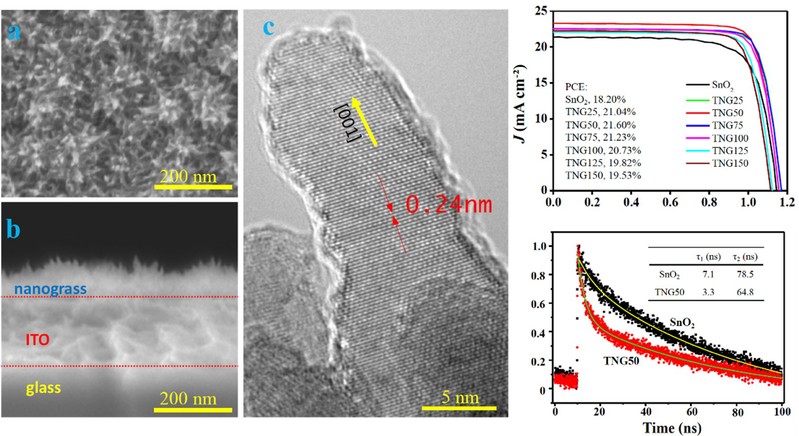Recently, Professor Zhan Yiqiang of the School of Information Science and Engineering of Fudan University and Professor Akrajas Ali Umar of the University of Malaysia have developed a highly efficient and stable perovskite solar cell based on a new design of nano-grass liked titanium dioxide electron transport layer. Related achievement was published in the Journal of Materials Chemistry A under the title of Enhancing the interfacial carrier dynamic in perovskite solar cells with ultrathin single-crystalline nanograss-like TiO2 electron transport layer. Professor Akrajas Ali Umar and doctoral student Zhang Xin are co-first authors of the paper.
Efficient electron transfer at the interface of electron transport layer (ETL) and the perovskite, transportation along the ETL and collection at the electrode, characteristics that are critically governed by the properties of the ETL, are fundamental for the fabrication of high-performance perovskite solar cells (PSC). So far, mesoporous TiO2 might have been considered as versatile ETL as its structure can provide enormous heterojunction with perovskite absorber. But, its inert (101) pores facet and massive dead-end pores structure as well as extensive grain boundary with the underneath layers in the PSC device have made them unlikely to meet those basic criteria.
Here, we come up with a new design of TiO2 ETL that provides a highly carrier dynamic in the device, that is 3 nm thick high-energy (001) faceted single-crystalline nanograss-like structure (TNG) that are vertically grown on the ITO surface. With these unique structural properties, we achieve an enhanced carrier extraction from the perovskite layer, transportation along the ETL and collection at the electrode. Our results indicate that the charge-transfer dynamic at the TNG-perovskites interface and transport in the device are up to more than 2 times faster than those in the control device or in the recently reported results. With this property, we record a power conversion efficiency (PCE) as high as 21.60% (or on average at the level of 20.84%) from the TNG-based PSC with the device area as high as ~ 0.17 cm2 using triple cation perovskite, an improvement as high as 18% from the control device. The TNG with unique structure and surface chemistry may transpire to be a potential platform for a fabrication of high-performance PSC device by combining with a high-performance perovskite system.
This work was financially supported by Shanghai Science and Technology Innovation Action Plan, Belt & Road Young Scientist Program (Grant No: 17160742900) and the National Natural Science Foundation of China (Grant No: 61774046).


